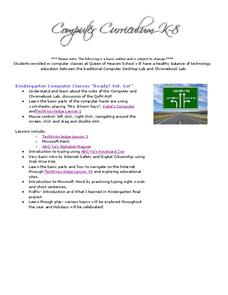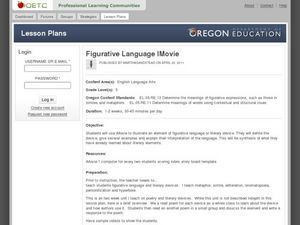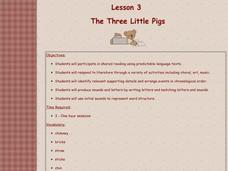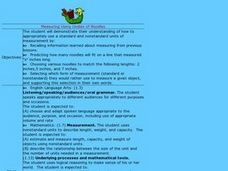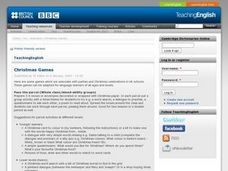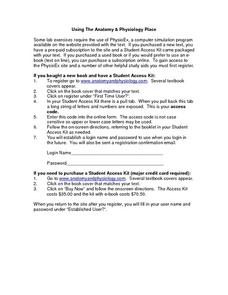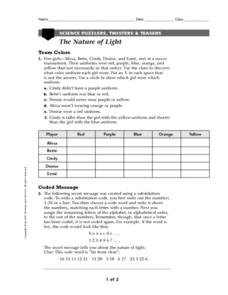Curated OER
Decimal and Fractions - Part One
Pupils explore the concept of converting decimals to fractions. In this conversion lesson, learners convert decimals to fractions.
Curated OER
Symmetry in Children's Art Experiences
Read between the lines of symmetry to make important connections between math, art, culture, and nature.
Curated OER
Understanding the Body, Day 1: Anatomy
Intended for moderate to severely disabled students, this instructional activity focuses on building an understanding of human anatomy. A secondary special education class reviews, identifies, and labels parts of the body. Including the...
EngageNY
Interpreting and Computing Division of a Fraction by a Fraction—More Models
Use a unit approach in developing a fraction division strategy. The teacher leads a discussion on division containing units, resulting in a connection between the units and like denominators. Pupils develop a rule in dividing fractions...
Queen of Heaven School
Computer Curriculum
Need some extra resources to get your class computer savvy? How about several years' worth? Show pupils in K-8 a progression of proficiency in a series of computer lessons. Learners master the basics, then work with the Microsoft Office...
Curated OER
High School Literary Paragraph Development
You can cover literary elements, writing organization, and proofreading skills in this SMART board lesson. Using student paragraphs from a previous assignment, the class reviews the best examples of writing. A SMART board activity guides...
Curated OER
Figurative Language iMovie
In order to understand figurative language, learners read 5 poems, each exemplifying a different literary device. They discuss and write responses to each poem. They then choose one literary device which they will use as the basis...
Curated OER
Musical Moods
To celebrate diversity and the purpose of Harmony Day, the class examines culturally diverse music and expression through line drawing. They discuss that all cultures produce music and that music can convey mood just like art can. As the...
Kentucky Department of Education
Multi-Digit Multiplication Strategies
There is more than one way to solve a multiplication problem, and many learners find that the lattice multiplication method can be a helpful one. Fourth graders take an initial formative assessment before working in groups of two or...
Laboratory for Atmospheric and Space Physics
Planetary Distances on the Playground
There's no need to stay inside; get out of the classroom and create a scaled map of the solar system on your playground field! In collaborative groups, scholars identify the distance between the sun and other planets, place planet...
University of Colorado
Planetary Distances on the Playground
Earth is 149,600,000 km, or 92,957,130.4 miles, from the sun. Young astronauts create an interactive model to learn the distances between planets. Nine groups, each representing a different planet, are spread around at class-calculated...
Curated OER
The Three Little Pigs
Learners analyze storytelling by reading a classic children's tale. In this reading comprehension lesson plan, students read The Three Little Pigs, discuss their predictions and practice using the vocabulary from the story....
Curated OER
Measuring Using Oodles of Noodles
First graders explore and evaluate the use of both standard and nonstandard forms of measurement. They use noodles to measure the lengths of each line they have drawn. They glue the noodles to the page under the given line.
Curated OER
Christmas Games
Your class will practice language and dialog skills by playing games associated with Christmas through these lesson ideas. Learners practice English conversation skills while simultaneously acquiring insight into their new culture. Games...
Curated OER
Canyons: Magic Square Activity
A fan of magic squares vocabulary activities? Readers use terms drawn from Gary Paulsen’s Canyons to complete an exercise. The worksheet, an answer sheet, as well as complete directions for crafting a magic square, are included.
Curated OER
Using The Anatomy and Physiology Place
In this health worksheet, students register for the use of a website that accompanies a textbook for the class of Anatomy and Physiology.
Curated OER
ARC Writing Lab Worksheets: Parallel Structure
In this parallel structure worksheet, learners read about parallel structure within sentences and between sentences, then complete a practice sheet of exercising, rewriting sentences. An answer key is given.
Curated OER
The Luck of the Irish
Students are introduced to a variety of customs and traditions relating to the culture of Ireland. They view a video, explore the art of storytelling, research sport origins, cook Irish food and discuss well-known Irish proverbs.
Curated OER
Desert Views: First Impressions
Students are introduced to primary source material and the ways in which early travelers viewed aspects of the desert environment. The lesson addresses the geography themes of location, region, and human/environment interaction.
Curated OER
Literature Review Paragraph
Tenth graders review the structural elements of a literary paragraph and organizational paragraph formats. They author a paragraph examining and reviewing a piece of literature currently being read in class. Students peer-review the...
Curated OER
Processing Satellite Images
Students comprehend the meaning of "pixel." They recognize patterns using pixels. Students observe how land use can be determined from a pixel. They measure off a 30 x 30-meter area to show the size of the surface area of one pixel....
Curated OER
The Nature of Light
In this science worksheet, students answer questions that are related to the concept of color and they discover what color shirts are being worn by reading the clues.
Curated OER
Contacting Outer Space
Students read a newspaper article about a compilation of information on human life that is to be projected into outer space from a pyramid in Mexico. They define vocabulary, complete comprehension worksheets, analyze the use of 'to' plus...
Curated OER
Kindergarten Exploration Tubs
Students identify their names as a symbol for themselves. They describe characteristics of organisms. They utilize tools to gather data and compare size.






